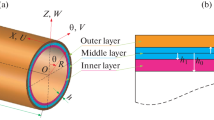Abstract
The stiffened cylindrical shell is commonly used for the pressure hull of submersibles and the legs of offshore platforms. There are various failure modes because of uncertainty with the structural size and material properties, uncertainty of the calculation model and machining errors. Correlations among failure modes must be considered with the structural reliability of stiffened cylindrical shells. However, the traditional method cannot consider the correlations effectively. The aim of this study is to present a method of reliability analysis for stiffened cylindrical shells which considers the correlations among failure modes. Firstly, the joint failure probability calculation formula of two related failure modes is derived through use of the 2D joint probability density function. Secondly, the full probability formula of the tandem structural system is given with consideration to the correlations among failure modes. At last, the accuracy of the system reliability calculation is verified through use of the Monte Carlo simulation. Result of the analysis shows the failure probability of stiffened cylindrical shells can be gained through adding the failure probability of each mode.
Similar content being viewed by others
References
Bhattacharya B, Basu R, Ma KT (2001). Developing target reliability for novel structures: the case of the Mobile Offshore Base. Marine Structures, 14, 37–58.
Cheng YS, Au FTK, Tham LG, Zeng GW (2004). Optimal and robust design of docking blocks with uncertainty. Engineering Structure, 26, 499–510.
Deng Jian, Gu Desheng (2005). Structural reliability analysis for implicit performance functions using artificial neural network. Structure Safety, 27, 25–48.
Gayton N, Bourinet JM, Lemaire M (2003). CQ2RS: a new statistical approach to the response surface methods for reliability analysis. Structure Safety, 25, 99–121.
Grooteman F (2008). Adaptive radial-based importance sampling method for structural reliability. Structural Safety, 30, 533–542.
Herbert MG, Armando MA (2004). Comparison of response surface and neural network with other methods of structural reliability analysis. Structure Safety, 26, 49–67.
Ma Yongliang (2009). Reliability assessment of submarine structure considering corrosion. Master thesis, Harbin Engineering University, 30–38.
Papadrakakis M, Lagaros ND (2002). Reliability-based structural optimization using neural networks and Monte Carlo simulation. Computer Methods in Applied Mechanics and Engineering, 192(32), 3491–3507.
Su Changqing, Zhang Yimin, Du Jinsong (2012). Frequency reliability analysis of rotor system with correlation failure modes. Journal of Mechanical Engineering, 48(6), 175–179.
Yu Yingxia, Liu Fengjun, Zhang Wei, Liang Bin (2012). Improving of RSM-FORM and application to reliability calculation of ring-stiffened cylindrical shell. Journal of Ship Mechanics, 16(3), 271–276.
Zoul T, Mahadevan S (2006). A direct decoupling approach for efficient reliability-based design optimization. Structural and Multidisciplinary Optimization, 31(3), 190–200.
Author information
Authors and Affiliations
Corresponding author
Additional information
Foundation item: The Defence Advance Research Program of Science and Technology of Ship Industry (Grant No. 11J1.3.1)
Xu Bai was born in 1984. He is an assistant professor at the Jiangsu University of Science and Technology and holds a PhD from Harbin Engineering University. His current research interests include subsea structural mechanics and reliability and risk assessment of offshore structures.
Liping Sun was born in 1962. She is a professor of the Harbin Engineering University. Her current research interests include concept design and analysis of drillship, and analysis of deepwater drilling risers, mooring system, deepwater floating structures, etc.
Wei Qin was born in 1985. He holds a PhD from the Harbin Engineering University. His current research interests include structural strength and fatigue performance of subsea risers and pipelines.
Yongkun Lv was born in 1983. He is a design engineer at Technical Institute, COSCO (Dalian) Shipyard Co., Ltd., and holds a bachelor’s degree from Harbin Engineering University. His current research interest includes detail design of vessel and offshore structures and subsea structural mechanics and reliability and risk assessment of offshore structures.
Rights and permissions
About this article
Cite this article
Bai, X., Sun, L., Qin, W. et al. Strength reliability analysis of stiffened cylindrical shells considering failure correlation. J. Marine. Sci. Appl. 13, 49–54 (2014). https://doi.org/10.1007/s11804-014-1236-z
Received:
Accepted:
Published:
Issue Date:
DOI: https://doi.org/10.1007/s11804-014-1236-z




